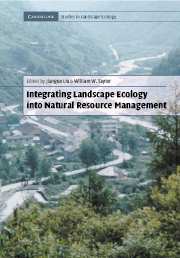Book contents
- Frontmatter
- Contents
- List of contributors
- Foreword
- Preface
- Acknowledgments
- PART I Introduction and concepts
- PART II Landscape structure and multi-scale management
- PART III Landscape function and cross-boundary management
- PART IV Landscape change and adaptive management
- 10 A landscape-transition matrix approach for land management
- 11 Tactical monitoring of landscapes
- 12 Landscape change: Patterns, effects, and implications for adaptive management of wildlife resources
- 13 Landscape ecology in highly managed regions: The benefits of collaboration between management and researchers
- PART V Landscape integrity and integrated management
- PART VI Syntheses and perspectives
- Index
- Plate Section
10 - A landscape-transition matrix approach for land management
Published online by Cambridge University Press: 14 January 2010
- Frontmatter
- Contents
- List of contributors
- Foreword
- Preface
- Acknowledgments
- PART I Introduction and concepts
- PART II Landscape structure and multi-scale management
- PART III Landscape function and cross-boundary management
- PART IV Landscape change and adaptive management
- 10 A landscape-transition matrix approach for land management
- 11 Tactical monitoring of landscapes
- 12 Landscape change: Patterns, effects, and implications for adaptive management of wildlife resources
- 13 Landscape ecology in highly managed regions: The benefits of collaboration between management and researchers
- PART V Landscape integrity and integrated management
- PART VI Syntheses and perspectives
- Index
- Plate Section
Summary
Introduction
Decision-makers are often unaware of the extent to which land-use changes affect biodiversity, renewable resource productivity (e.g., timber), movement of species, and the overall sustainability of ecosystems. Thus, there is a need to estimate ecological effects of land-use change. Adaptive management is a process that considers policy decisions as experimental hypotheses that are subject to testing, analysis, and mediation (Holling, 1978; Walters, 1986). The approach can be used to evaluate the impacts of management actions on natural resources and to modify management actions to protect those resources. Adaptive management emphasizes decision-making as a continuing process, not a discrete end point (Heifetz, 1994).It views management actions as experiments and accumulates knowledge to achieve continual learning (Christensen et al., 1996; Stanford and Poole, 1996). Critical elements for adaptive management include (1) reviewing and synthesizing existing information, (2) defining the ecosystem based on available science, (3) identifying goals based on scientific synthesis and values of the general public, (4) developing a peer-review management system, (5) implementing management actions that meet stated goals within the parameters of acceptable risks and consequences, and (6) conducting applied research and monitoring to reduce uncertainties and evaluate management actions. Adaptive management assumes an ongoing, iterative process that can adjust to new information, changing societal goals, and changes in environmental conditions that occur over a broad scale or over a long time. Thus, adaptive management provides a useful paradigm in which to consider land-use effects on ecological systems.
The ecological impacts on which this paper focuses derive from the ecological principles for land use identified by the Ecological Society of America's Land Use Committee (Dale et al., 2000).
- Type
- Chapter
- Information
- Integrating Landscape Ecology into Natural Resource Management , pp. 265 - 293Publisher: Cambridge University PressPrint publication year: 2002
- 7
- Cited by

